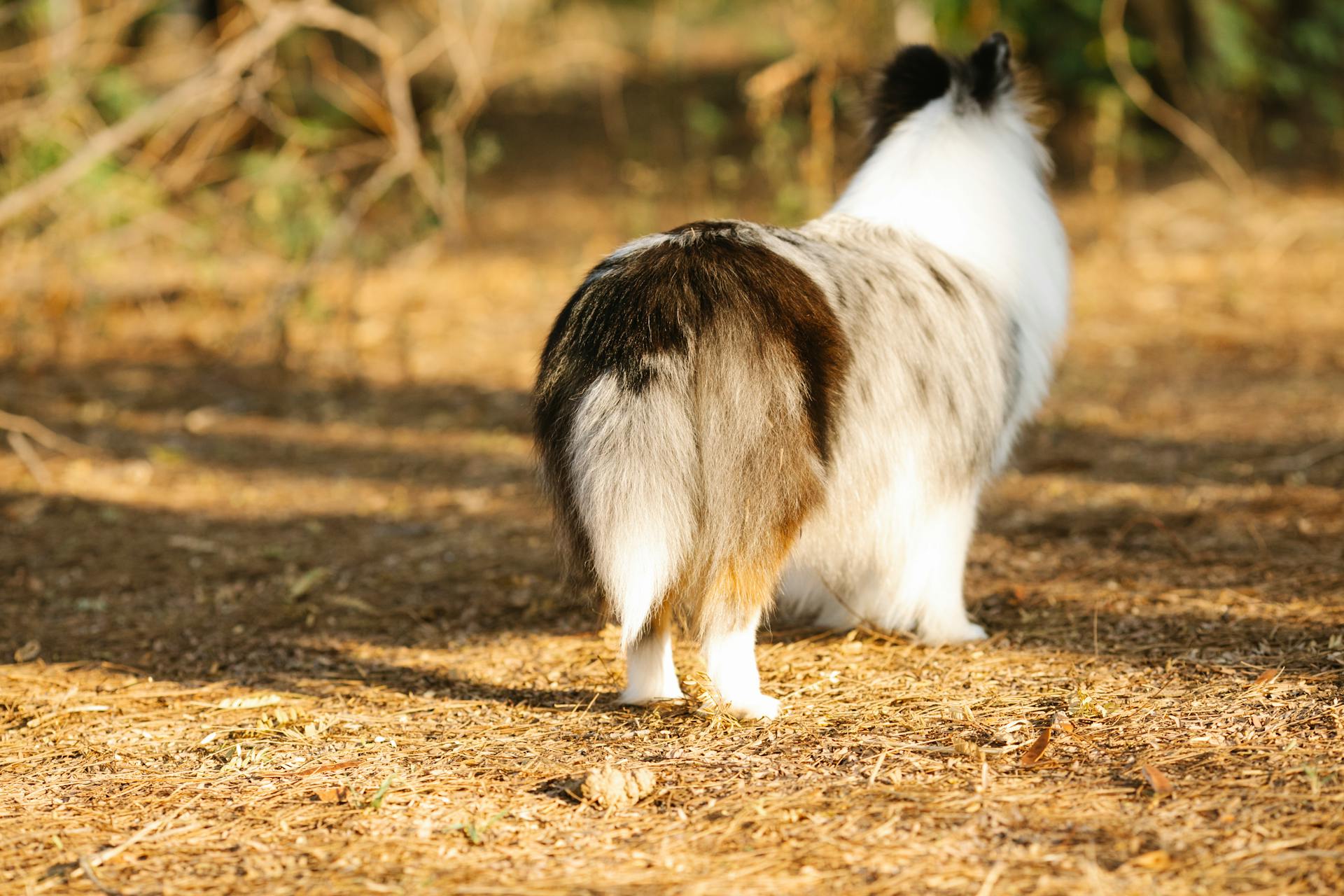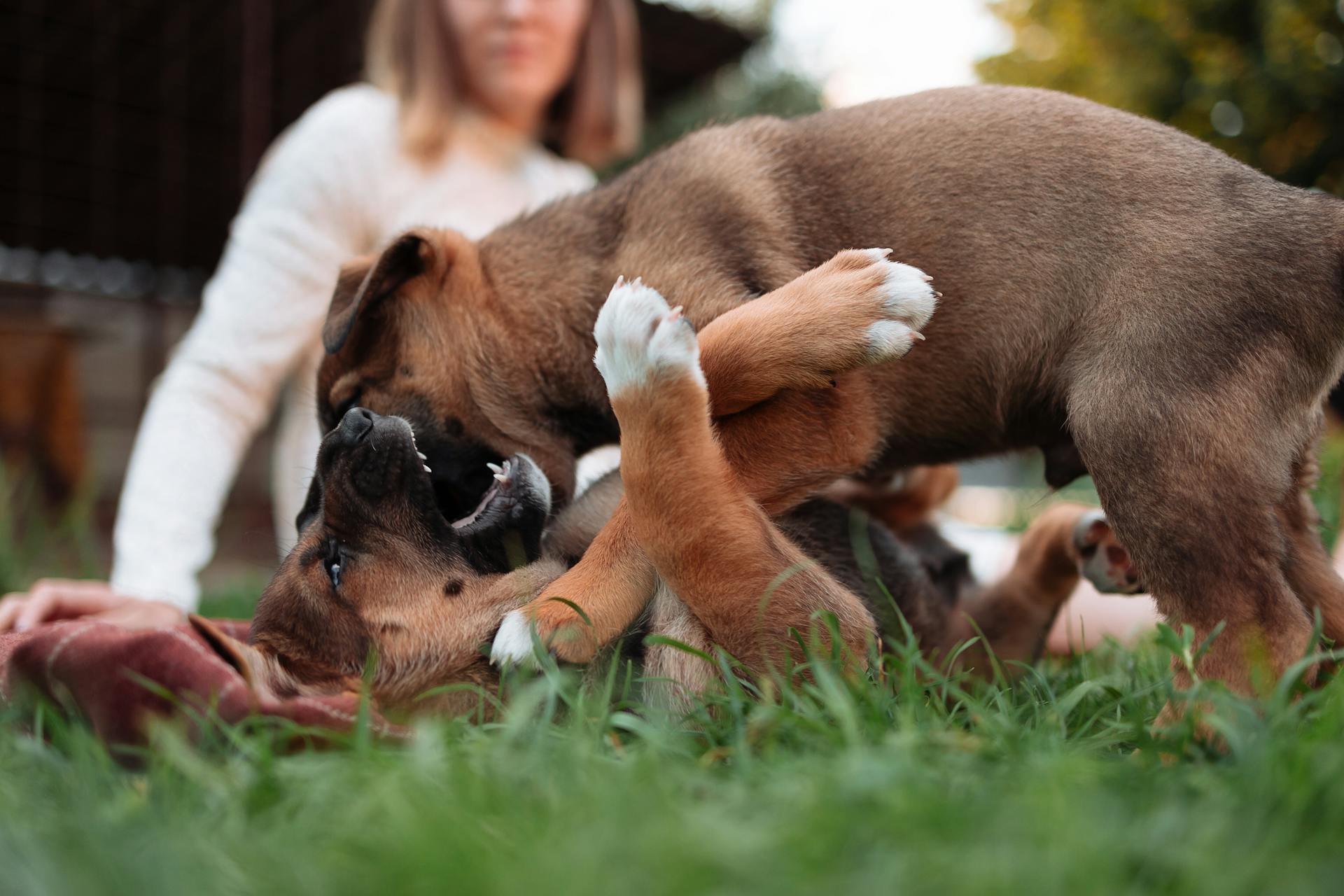
Reading your dog's body language is a vital part of understanding their behavior and needs. A wagging tail is often seen as a sign of happiness, but a circle wag can be a different story.
A circle wag is often a sign of anxiety or stress in dogs. This behavior can be a warning sign that your dog is feeling uneasy or threatened.
Dogs will often circle their tails when they're feeling uncertain or insecure. This can be due to a variety of factors, including changes in their environment or social situations.
Pay attention to the speed and movement of your dog's tail when interpreting a circle wag. A fast, tense circle wag can indicate a higher level of anxiety or stress.
Additional reading: Dog Behavior
What Does Tail Wagging Mean in Dogs?
A dog's tail wag is like their way of talking, and the position and speed of the wag convey different emotions. The base of the tail reveals the ever-important tail set, or position.
The tail's position can be thought of as words, and the speed of the wag is like the volume of their voice. The faster the tail wag, the louder the voice.
A small tail wag is a welcoming gesture, while a broad wag means the dog is friendly. A slow tail wag can indicate insecurity about a situation.
A stiff tail is not a good sign, and may indicate hostility. Research shows that if the dog is wagging their tail to the right, they're experiencing positive emotions, while wagging to the left indicates negative feelings.
Pay attention to how the dog is holding its tail and body, as this can give you a clue about what they're trying to communicate. A wagging tail doesn't always mean the dog is happy, but it's often a sign of a positive social interaction.
Additional reading: Dogs Ears Back Tail Wagging
Reading a Dog's Body Language
Reading a dog's body language is crucial to understanding what they're trying to communicate. It's like learning a new language, and with practice, you can become fluent.
The tail is a key indicator of a dog's emotions, with the position and speed of the wag revealing their mood. A relaxed tail position, often hanging down by the heels, can indicate a calm dog. But be aware that some breeds have upright tails by default.
Pay attention to the tail's base, as it reveals the tail set or position. This, combined with the angle of the wag, helps determine the intensity of the emotion. For example, a moderate speed, full, sweeping wag can indicate a relaxed dog approaching for a positive social interaction.
A small tail wag can be a welcoming gesture, while a broad wag suggests the dog is friendly. However, a slow wag can indicate insecurity, and a stiff tail can be a sign of hostility.
Reading a Dog's Tail
Dogs use their tails to communicate different emotions, and it's essential to pay attention to both the tail position and the speed of the wag.
The tail position can be thought of as "words", and the speed of the wag can be compared to how loud their voice is. The faster the tail wag, the louder the voice.
The average dog's "relaxed" tail position is hanging down by their heels, but some breeds have an upright natural tail position, and others don't have tails at all. Pay attention to the tail's base to determine the tail set (or position).
The tail's position can reflect a dog's general mood, such as scared, excited, concerned, curious, happy, or angry. The wag indicates the intensity of that emotion, with more exaggerated movements indicating a stronger feeling.
A small tail wag is a welcoming gesture, while a broad wag means the dog is friendly. A slow tail wag can suggest insecurity about a situation, regardless of the tail's position.
Dogs also wag their tails to communicate with humans and other animals. Pay attention to how the dog is holding its tail and its body language to get a better understanding of what it's trying to communicate.
Research has shown that if a dog is wagging its tail to the right, it's experiencing positive emotions, while a leftward wag indicates something is bothering it. This is because the brain's left hemisphere controls the right side of the body and vice versa.
By paying attention to a dog's tail wag and position, you can better understand its emotions and intentions. This can help you build a stronger bond with your furry friend and even prevent potential conflicts.
Recommended read: Why Does a Dog Tail Wag
Avoidance
Dogs use avoidance behaviors to signal that they want to be left alone. They may stop wagging their tail and move away.
If a dog is exhibiting avoidance signals, it's essential to respect their boundaries and give them space. Approaching them in this state can escalate to submission or aggression.
A dog's avoidance signals can manifest in behaviors like self-grooming or sniffing the ground. These behaviors are a clear indication that they need some time and space to themselves.
If you're able to give a dog some space, they may be willing to come to you after some time.
Related reading: What Kind of Pain Meds Can I Give My Dog
How Dogs Communicate
Dogs use their tails to communicate emotions, but it's not just about happiness. A wagging tail can mean anything from excitement to submission, and even aggression.
A tail-wagging dog is like waving a white flag of surrender, indicating they're happy to see you and present no threat. But, it's essential to consider the context and other body language cues to understand what they're trying to communicate.
For more insights, see: Tail Wagging by Dogs News
Dogs without tails use vocalizations and body language to express emotions. They use their voice, facial expressions, moving their tongue, eye position, ear position, stance, and movement to convey messages.
Here are some ways dogs use their body language to communicate:
- Vocalizations: barking, growling, snarling, whimpering, whining, crying, howling
- Facial expressions
- Moving their tongue, such as lip-licking
- Eye position
- Ear position: flattened, perked up, relaxed, pinned
- Stance/posture: hunched, cowering, play bowing, hackles raised, stiff/frozen, body weight shifting forward or back
- Movement: stiff/frozen, lying down, walking around, lunging, “tip-toeing,” moving backward, turning head away
To read a dog's tail wag, pay attention to the tail's position and the speed of the wag. A raised tail can imply dominance, while a horizontal tail can hint at neutrality. A low tail can mean submission, and frantic wagging implies excitement.
The feeling conveyed by a dog's tail wag depends on two factors: the tail position and the speed of the wag. The speed of the wag is like the volume of their voice, with faster wags indicating more intense emotions.
Here are some emotions a dog can convey through wagging their tail:
- A small tail wag indicates a welcoming gesture.
- A slow tail wag can convey insecurity about a situation.
- A stiff tail can indicate hostility.
- A tail wag to the right can indicate positive emotions, while a wag to the left can indicate negative emotions.
Happy
A happy dog is a wonderful thing to be around, and one of the best indicators of a dog's happiness is their tail wag.
If a dog's tail is relaxed and moving back and forth, it's a good sign that they're feeling happy and comfortable.
Their body will often move along with the wagging, so if you see a dog's whole body swaying from side to side, it's likely a happy dog.
A happy facial expression is also a good indicator, so look for bright eyes, a relaxed open mouth, and possibly a gentle pant.
Fast tail wagging with other happy signals usually means the dog is excited, so if you see a dog wagging their tail quickly and enthusiastically, they're probably feeling happy and engaged.
Research has also shown that if a dog is wagging their tail to the right, they're experiencing positive emotions, so if you see a dog wagging their tail to the right, it's a good sign that they're feeling happy and content.
Readers also liked: Dogs Hair Standing up and Tail Wagging
Sources
- https://vcahospitals.com/know-your-pet/interpreting-tail-wags-in-dogs
- https://www.scientificamerican.com/article/why-do-dogs-wag-their-tail/
- https://www.petmd.com/dog/behavior/why-do-dogs-wag-their-tails
- https://dogo.app/dog-tail-wags/
- https://www.thesprucepets.com/dog-body-language-wagging-tail-1118252
Featured Images: pexels.com


